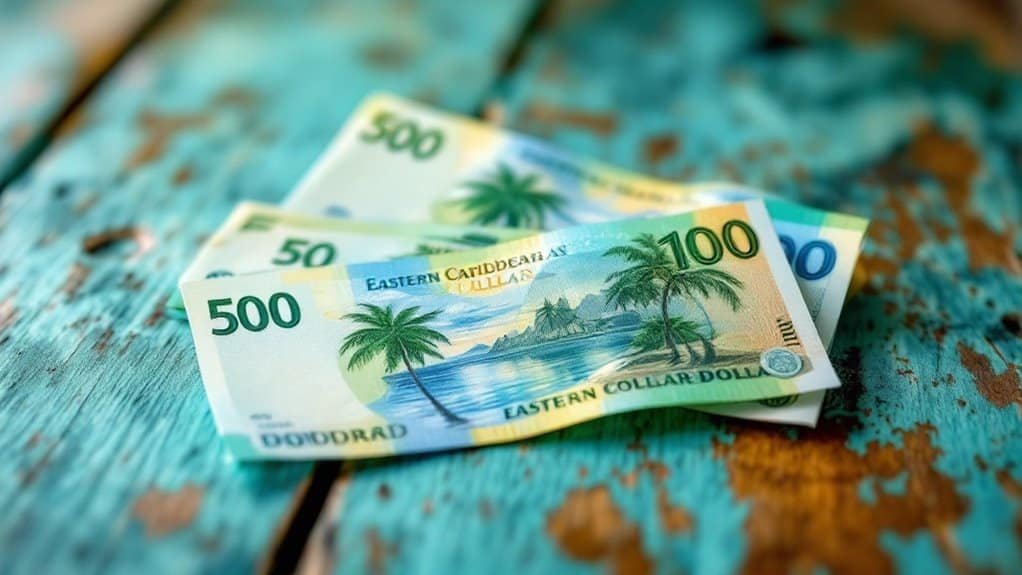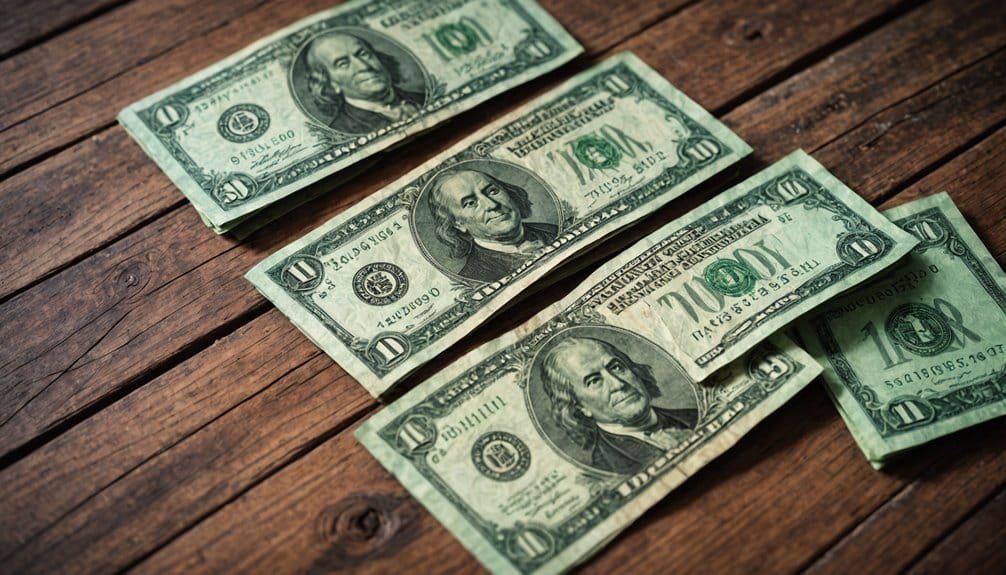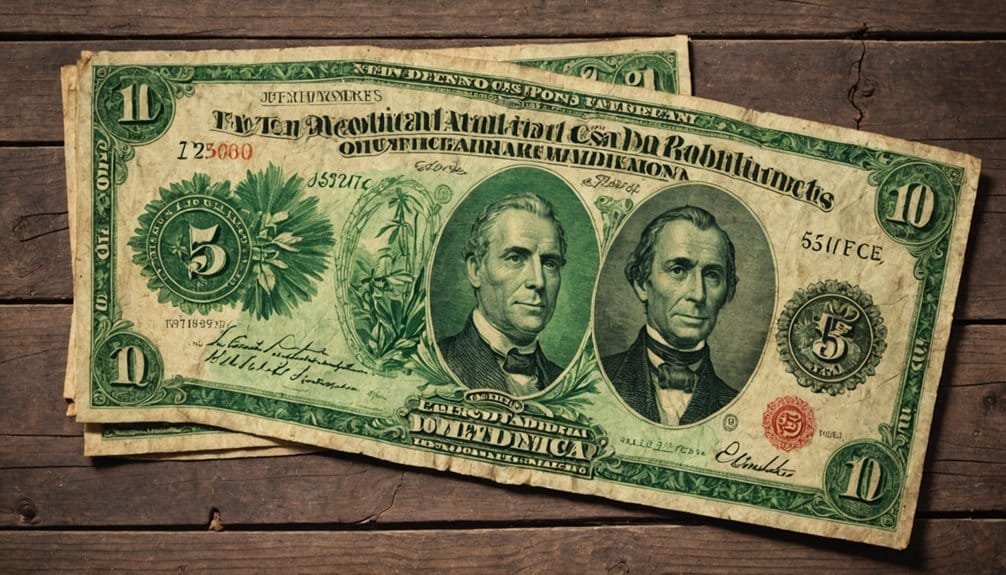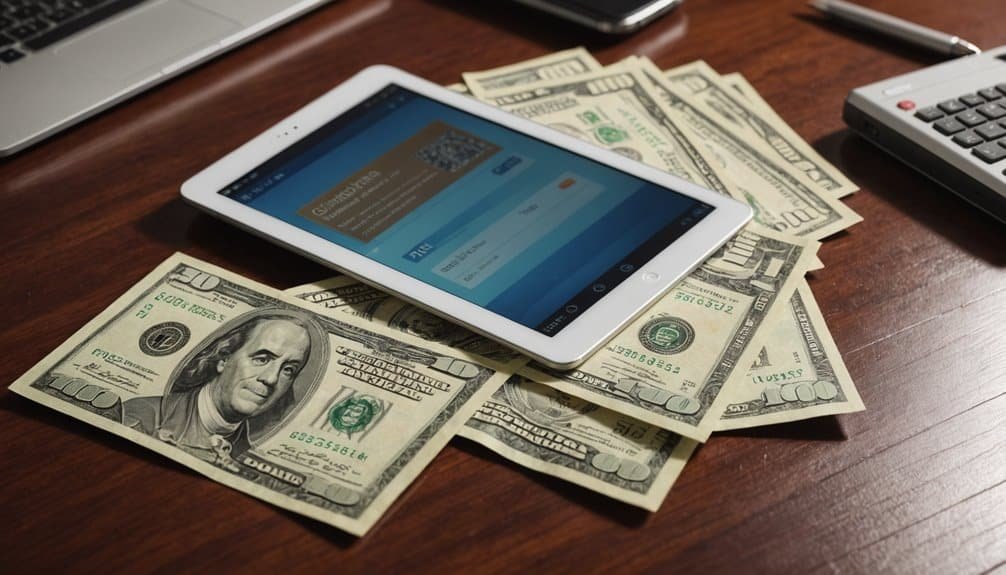
The Eastern Caribbean Dollar (XCD) is Dominica's official currency, offering a stable 2.70 XCD to 1 USD exchange rate. You'll find it used across local markets, restaurants, and tourist destinations, with coins and banknotes ranging from 1 cent to 100 Dollars. Issued by the Eastern Caribbean Central Bank, the XCD represents a unified monetary system connecting eight Caribbean nations. While credit cards work in tourist areas, you'll want local currency for most transactions. ATMs provide convenient XCD withdrawals, and understanding the currency's nuanced exchange rates can help maximize your spending power. The evolving financial landscape suggests even more intriguing monetary developments await.
Key Takeaways
- The Eastern Caribbean Dollar (XCD) is the official currency of Dominica, issued by the Eastern Caribbean Central Bank and maintaining a stable exchange rate of 2.70 XCD to 1 USD.
- Travelers can easily use XCD in local markets, restaurants, and shops across Dominica, with most prices displayed in the local currency and some establishments also accepting USD.
- ATMs in Dominica provide convenient access to XCD, allowing tourists and locals to withdraw local currency and manage financial transactions throughout the Eastern Caribbean region.
- The XCD is part of a broader monetary union that includes eight Caribbean countries, promoting economic cooperation and financial stability across participating island nations.
- Digital currency innovations, including a blockchain-based pilot program, are transforming the Eastern Caribbean Dollar's financial infrastructure to enhance transaction efficiency and technological adaptability.
What Is the Eastern Caribbean Dollar?
The resilience of regional monetary cooperation finds expression in the Eastern Caribbean Dollar (XCD), a unified currency serving multiple Caribbean nations.
When you explore its currency features, you'll discover a robust monetary instrument introduced in 1965, replacing the British West Indies Dollar. The XCD isn't just a symbol of economic unity; it's a strategic monetary policy tool issued by the Eastern Caribbean Central Bank (ECCB).
You'll notice the currency's distinctive denominations: coins ranging from 1 to 25 cents and a 1 Dollar coin, alongside banknotes of 5 to 100 Dollars.
Its fixed exchange rate system, pegged at 2.70 XCD to 1 USD, demonstrates a calculated approach to economic stability. This monetary framework supports the region's economies, which primarily depend on tourism, agriculture, and offshore financial services. The currency's stability is further reinforced by the centralized monetary management of the Eastern Caribbean Central Bank, which coordinates fiscal policies across member territories.
Understanding Currency Exchange Rates
A dynamic landscape of financial interactions emerges when examining currency exchange rates for Dominica's Eastern Caribbean Dollar (XCD).
You'll find that the XCD maintains a fixed rate of 2.70 XCD to 1 USD, which provides stability for travelers and businesses. When exploring exchange rate fluctuations, you'll notice that while the core rate remains consistent, economic activities can influence short-term variations.
Currency conversion tips become essential for managing transactions. For instance, 10 XCD equates to 3.70 USD, making quick calculations straightforward.
Understanding these rates helps you make informed financial decisions when visiting tourist areas where multiple currencies are accepted. By tracking daily, weekly, and monthly rate changes, you can optimize your monetary exchanges and maximize your financial planning in the Eastern Caribbean region. The current mid-market rate of 1 XCD = C$0.5241 CAD provides additional context for international currency comparisons mid-market reference rate.
Economic Cooperation and Monetary Union

Strategically positioned within the Caribbean region, the Eastern Caribbean Currency Union (ECCU) represents a sophisticated model of economic cooperation and monetary integration.
By uniting eight member countries, the ECCU enables extensive monetary cooperation through a unified approach to fiscal policies and economic management.
You'll find that this regional economic alliance facilitates the free movement of goods, services, and capital, creating a robust platform for shared economic development.
The Eastern Caribbean Central Bank plays a pivotal role in maintaining stability, regulating the Eastern Caribbean dollar, and ensuring a consistent monetary framework.
The union's strategic alignment allows member states like Dominica to benefit from collective economic strength, synchronized monetary policies, and enhanced regional financial resilience.
This collaborative approach minimizes individual economic vulnerabilities while promoting sustainable growth. Exchange rate management by the central bank provides a critical mechanism for maintaining economic stability across the member states.
Where Can You Use XCD?
When you explore Dominica's vibrant tourist destinations and local markets, you'll find the East Caribbean Dollar (XCD) is the primary currency for transactions. Given the current stable exchange rate of 1 XCD = 0.3704 USD, travelers can confidently engage in local economic exchanges. You'll notice that prices in restaurants, shops, and street vendors are consistently marked in XCD, ensuring smooth and accurate financial exchanges. As a traveler, you should prioritize using local currency to maximize transaction value and align with regional economic practices.
Tourist Hotspot Acceptance
Throughout Dominica's vibrant tourism landscape, the Eastern Caribbean Dollar (XCD) demonstrates remarkable versatility across multiple spending environments.
Tourist spending patterns reveal clear currency preferences that travelers should understand before visiting.
Key XCD acceptance zones include:
- Hotels offering prices in both XCD and USD, with widespread credit card integration
- Restaurants ranging from local eateries to upscale dining establishments accepting multiple currencies
- Tourist attractions and tour operators providing flexible payment options
- Retail environments where larger stores readily accept both local and international currencies
ATM accessibility ensures travelers can conveniently withdraw local currency throughout the island, providing additional financial flexibility.
While credit cards like Visa and Mastercard are commonly used, travelers should carry some cash in XCD for smaller vendors and local experiences.
Understanding these currency dynamics guarantees smooth financial transactions throughout Dominica's diverse tourism landscape, allowing visitors to navigate monetary exchanges with confidence and ease.
Local Market Venues
The local market venues in Dominica represent critical financial ecosystems where Eastern Caribbean Dollars (XCD) serve as the primary transactional medium.
When shopping in stores and restaurants, you'll find prices displayed in XCD, with the $ symbol representing local currency. Most merchants prefer XCD and typically don't accept foreign currencies, making local currency essential for seamless transactions.
Market preferences lean heavily towards cash-based interactions, with common banknote denominations ranging from $5 to $100 and coins from $1 to $25.
Travelers should prioritize obtaining XCD through city center exchange providers, which offer more favorable rates compared to airport or hotel exchanges. Central bank regulations significantly influence the currency's stability and exchange practices in local markets.
Historical Evolution of Caribbean Currency

You'll trace the Caribbean currency's evolution from its colonial monetary roots, where the British West Indies dollar dominated the regional economic landscape from 1935 to 1965.
The establishment of the British Caribbean Currency Board in 1951 marked a critical turning point, granting member territories sovereign rights to issue their own currency and laying the groundwork for future monetary integration.
Through strategic economic planning and regional collaboration, these territories shifted from a colonial currency system to the Eastern Caribbean dollar, creating a unified monetary framework that continues to support economic stability across multiple island nations. The ECCB's headquarters in Saint Kitts and Nevis symbolized the centralized approach to regional monetary policy and economic coordination.
Colonial Monetary Roots
Colonial monetary systems in the Caribbean emerged as complex frameworks reflecting imperial economic strategies, with British colonial administration playing a pivotal role in standardizing regional currency.
The British West Indies Dollar exemplified these colonial influences, demonstrating a systematic approach to monetary legacy through strategic financial design. The Eastern Caribbean Currency Authority, established in 1965, further consolidated monetary integration by creating a unified currency system for multiple Caribbean territories.
Key aspects of this colonial monetary framework included:
- Establishment of a unified currency across British territories
- Fixed conversion rates linked to British pound sterling
- Centralized monetary control from London
- Gradual shift from fragmented local currencies to standardized systems
The introduction of the British West Indies Dollar in 1949 represented a calculated move to consolidate economic governance.
Currency Board Origins
Building upon the British colonial monetary framework, Caribbean currency boards emerged as sophisticated financial mechanisms designed to standardize and stabilize regional economic systems. The British Caribbean Currency Board (BCCB), established in 1950, was a pivotal institution that exercised sole power to issue currency for multiple British-controlled Caribbean territories. Regional economic integration was a key driver in the evolution of these monetary institutions, facilitating closer cooperation among Caribbean nations.
| Period | Currency Board | Key Function |
|---|---|---|
| 1950-1965 | BCCB | Currency Issuance |
| 1965-1983 | ECCA | Regional Monetary Coordination |
| 1983-Present | ECCB | Monetary Policy & Supervision |
| Ongoing | Current System | Currency Stability |
The shift from BCCB to Eastern Caribbean Currency Authority (ECCA) and subsequently to the Eastern Caribbean Central Bank (ECCB) reflected an evolving approach to monetary authority. These institutions prioritized currency stability, establishing the Eastern Caribbean Dollar as a robust financial instrument pegged initially to the pound sterling and later to the US dollar, ensuring economic consistency across participating island economies.
Regional Economic Integration
Throughout the mid-20th century, the Caribbean's monetary landscape underwent a transformative journey toward regional economic integration, driven by complex geopolitical and economic forces. Currency standardization through the Eastern Caribbean Central Bank provided a critical framework for monetary stability across the member states.
The Caribbean Community (CARICOM), established in 1973, became a pivotal mechanism for advancing regional trade and economic policies. Its strategic objectives included:
- Creating a unified market for goods and services
- Facilitating freedom of movement for labor and capital
- Harmonizing macroeconomic frameworks across member states
- Negotiating collaborative trade agreements with neighboring countries
The Organization of Eastern Caribbean States (OECS) further solidified this integration by establishing the Eastern Caribbean Currency Union.
Practical Tips for Currency Travelers
When traveling to Dominica, understanding the local currency and exchange dynamics can greatly enhance your financial preparedness. Currency conversion rates from the Eastern Caribbean region show that 1 USD equals approximately 2.7 XCD, making travel budgeting straightforward. Credit cards work well in tourist areas, but carry local currency for transactions outside these zones.
Before your trip, check current mid-market exchange rates and set up currency alerts. ATMs and exchange services are readily available to help manage your finances.
While the Eastern Caribbean Dollar remains stable, it's wise to convert modest amounts of money as needed. Major currencies like Euros and British Pounds are often accepted, providing flexibility.
Always keep small denominations of XCD for local markets, transportation, and smaller establishments.
Understanding these currency dynamics will help you navigate Dominica's financial landscape confidently and efficiently.
Future of Eastern Caribbean Financial Systems

The financial ecosystem of the Eastern Caribbean is poised for significant transformation, driven by innovative technological solutions and adaptive monetary strategies. The region's commitment to digital currency and financial inclusion is evident through the ECCB's blockchain-based currency pilot, which aims to revolutionize traditional banking systems. Blockchain technology through IBM's Hyperledger Fabric platform will enable secure and efficient digital currency management.
Key developments include:
- Implementation of a digital Eastern Caribbean dollar to reduce transaction costs
- Expansion of financial services through technological innovation
- Strategic responses to economic challenges posed by COVID-19
- Enhanced monetary policies supporting regional economic resilience
You'll witness a gradual shift towards more efficient, accessible financial infrastructure.
The digital currency initiative represents a forward-thinking approach to overcoming traditional banking limitations, potentially positioning the Eastern Caribbean as a progressive financial technology hub.
Conclusion
Dominica's currency journey reveals remarkable resilience. You'll find the Eastern Caribbean Dollar symbolizes regional economic collaboration, binding Caribbean nations through shared monetary strategies. As global financial landscapes shift, you'll appreciate how XCD represents more than money—it's a demonstration of collaborative economic governance. Your understanding of this currency highlights the intricate balance between local autonomy and regional economic integration, promising continued financial innovation.







Interesting read. Isnt it fascinating how the Eastern Caribbean Dollar has maintained stability despite economic fluctuations? I wonder what factors contribute to this resilience? Could it be the influence of monetary union?
Interesting read, but isnt it odd that the Eastern Caribbean Dollar is pegged to the US Dollar? Doesnt this limit economic autonomy for Dominica and other user nations? Thoughts?
Interesting read on Dominicas currency! I wonder, given the global shift towards digital currencies, how might the Eastern Caribbean Dollar adapt? Could this spur economic growth or pose risks?
Interesting read, but isnt it high time the Eastern Caribbean Dollar got pegged to a stronger currency other than USD? Just a thought…
Interesting read. But wouldnt a unified Caribbean currency streamline economic cooperation further? Just a thought.